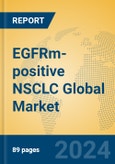EGFRm-positive NSCLC (Epidermal Growth Factor Receptor mutation-positive Non-Small Cell Lung Cancer) represents a critical segment of the oncology market, focusing on targeted therapies for patients with EGFR mutations, a subset of NSCLC that significantly impacts lung cancer treatment strategies. This market revolves around precision medicine, leveraging tyrosine kinase inhibitors (TKIs) and other novel therapies to address tumor growth driven by EGFR mutations, offering improved survival rates and quality of life compared to traditional chemotherapy. Situated within the broader oncology and biopharmaceutical sector, it depends on advanced diagnostics, robust clinical research, and regulatory approvals for innovative drugs.
The market is propelled by rising lung cancer prevalence, advancements in genomic profiling, and growing demand for personalized treatments, with innovations like next-generation TKIs and combination therapies reshaping its trajectory. It serves oncologists, healthcare providers, and patients seeking effective, mutation-specific solutions in a landscape increasingly defined by biomarker-driven care.
This product will be delivered within 1-3 business days.
The market is propelled by rising lung cancer prevalence, advancements in genomic profiling, and growing demand for personalized treatments, with innovations like next-generation TKIs and combination therapies reshaping its trajectory. It serves oncologists, healthcare providers, and patients seeking effective, mutation-specific solutions in a landscape increasingly defined by biomarker-driven care.
Market Size and Growth Forecast
The global EGFRm-positive NSCLC market is estimated to be valued between USD 4 billion and USD 5 billion in 2025, with a projected compound annual growth rate (CAGR) of 6% to 7.5% from 2025 to 2030, reaching approximately USD 5.6 billion to USD 7 billion by 2030. Growth is driven by increasing diagnosis rates and therapeutic advancements.Regional Analysis
- North America: Growing at 5-6%, the U.S. leads with advanced diagnostics and high adoption of targeted therapies, trending toward combination treatments and early screening.
- Europe: With a 5-6% growth rate, Germany, France, and the UK dominate, driven by strong healthcare systems and research, with precision medicine integration trending.
- Asia Pacific: Exhibiting a 7-9% growth rate, China, Japan, and South Korea excel, fueled by rising lung cancer incidence and healthcare investments, with affordable TKIs trending.
- Middle East and Africa (MEA): Growing at 4-5%, UAE and Saudi Arabia advance with improving oncology care, focusing on access to novel therapies.
- South America: With a 4-5% growth rate, Brazil leads with growing awareness and treatment access, emphasizing cost-effective options.
Product Type Analysis
- Afatinib: Expected at 5-6%, this second-generation TKI offers irreversible binding, with trends toward broader mutation coverage.
- Amivantamab: Projected at 6-8%, this bispecific antibody targets EGFR and MET, trending toward combination use in resistant cases.
- Dacomitinib: Expected at 5-6%, this second-generation TKI focuses on potency, with steady use in specific mutations.
- Others: Projected at 6-7%, emerging therapies like third-generation TKIs and novel agents grow, with innovation driving adoption.
Key Market Players
- AstraZeneca: A global leader delivering groundbreaking oncology solutions for targeted cancer care.
- Johnson & Johnson: A powerhouse innovating in bispecific antibodies for complex cancers.
- Takeda Pharmaceutical: A dynamic force advancing precision therapies for NSCLC patients.
- Blueprint Medicines Corp: A trailblazer in kinase inhibitors for mutation-driven cancers.
- Dizal Pharmaceutical: A rising star crafting novel treatments for Asian markets.
- Oric Pharmaceuticals: A creative pioneer in overcoming cancer resistance mechanisms.
- Black Diamond Therapeutics Inc.: An agile innovator targeting EGFR mutation landscapes.
- Taiho Pharmaceutical Co. Ltd.: A spirited provider of oncology breakthroughs for global reach.
- Boehringer Ingelheim: A robust player enhancing NSCLC treatment efficacy.
- Bayer AG: A versatile leader in oncology innovation and patient care.
- ArriVent Biopharma: An emerging force in precision oncology solutions.
Porter’s Five Forces Analysis
- Threat of New Entrants: Low, with high R&D costs, regulatory hurdles, and patent protections limiting entry.
- Threat of Substitutes: Medium, as chemotherapy and immunotherapy compete, but targeted therapies’ efficacy retains dominance.
- Bargaining Power of Buyers: Medium, with healthcare systems negotiating prices, patients less influential.
- Bargaining Power of Suppliers: Medium, with reliance on biotech inputs offset by large-scale sourcing.
- Competitive Rivalry: High, with firms battling over innovation, efficacy, and market share.
Market Opportunities and Challenges
Opportunities
- Rising lung cancer prevalence: Increasing NSCLC cases globally drive demand, amplifying the need for EGFR-targeted solutions.
- Genomic profiling advances: Enhanced diagnostics boost mutation detection, expanding the treatable patient pool.
- Personalized medicine growth: Demand for tailored therapies elevates market potential, targeting specific EGFR mutations.
- Combination therapy trends: Integrating TKIs with other agents enhances efficacy, opening new treatment avenues.
- Emerging market expansion: Growing healthcare access in Asia offers untapped potential, supported by cost-effective drugs.
Challenges
- High R&D costs: Developing novel therapies strains budgets, challenging smaller firms.
- Drug resistance: Emerging resistance to TKIs threatens efficacy, needing continuous innovation.
- Regulatory complexity: Stringent approval processes delay market entry, raising costs.
- Competitive alternatives: Immunotherapies and other targeted drugs vie for share, requiring differentiation.
- Access disparities: Limited healthcare infrastructure in some regions hampers adoption, needing outreach.
This product will be delivered within 1-3 business days.
Table of Contents
Chapter 1 Executive SummaryChapter 2 Abbreviation and Acronyms
Chapter 3 Preface
Chapter 4 Market Landscape
Chapter 5 Market Trend Analysis
Chapter 6 Industry Chain Analysis
Chapter 7 Latest Market Dynamics
Chapter 8 Historical and Forecast Egfrm-Positive Nsclc Market in North America (2020-2030)
Chapter 9 Historical and Forecast Egfrm-Positive Nsclc Market in South America (2020-2030)
Chapter 10 Historical and Forecast Egfrm-Positive Nsclc Market in Asia & Pacific (2020-2030)
Chapter 11 Historical and Forecast Egfrm-Positive Nsclc Market in Europe (2020-2030)
Chapter 12 Historical and Forecast Egfrm-Positive Nsclc Market in MEA (2020-2030)
Chapter 13 Summary For Global Egfrm-Positive Nsclc Market (2020-2025)
Chapter 14 Global Egfrm-Positive Nsclc Market Forecast (2025-2030)
Chapter 15 Analysis of Global Key Vendors
List of Tables and Figures
Companies Mentioned
- AstraZeneca
- Johnson & Johnson
- Takeda Pharmaceutical
- Blueprint Medicines Corp
- Dizal Pharmaceutical
- Oric Pharmaceuticals
- Black Diamond Therapeutics Inc.
- Taiho Pharmaceutical Co. Ltd.
- Boehringer Ingelheim
- Bayer AG
- ArriVent Biopharma








